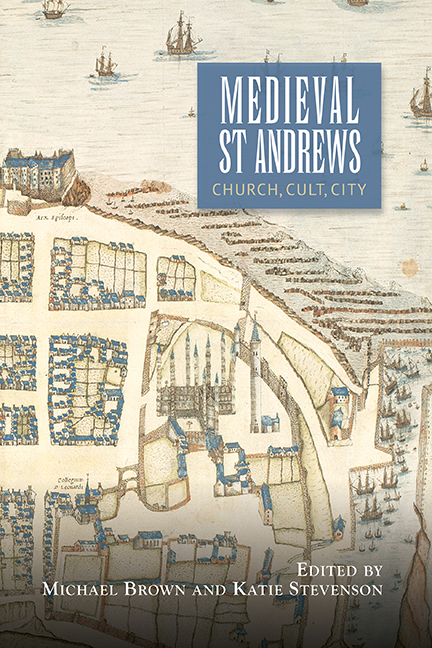Book contents
- Frontmatter
- Dedication
- Contents
- List of Illustrations, Charts and Tables
- Contributors
- Abbreviations
- 1 ‘Ancient Magnificence’: St Andrews in the Middle Ages: An Introduction
- 2 From Cinrigh Monai to Civitas Sancti Andree: A Star is Born
- 3 The Idea of St Andrews as the Second Rome Made Manifest
- 4 The Medieval Ecclesiastical Architecture of St Andrews as a Channel for the Introduction of New Ideas
- 5 When the Miracles Ceased: Shrine and Cult Management at St Andrews and Scottish Cathedrals in the Later Middle Ages
- 6 Religion, Ritual and the Rhythm of the Year in Later Medieval St Andrews
- 7 Living in the Late Medieval Town of St Andrews
- 8 The Burgh of St Andrews and its Inhabitants before the Wars of Independence
- 9 The Archaeology of Medieval St Andrews
- 10 Prelates, Citizens and Landed Folk: St Andrews as a Centre of Lordship in the Late Middle Ages
- 11 Augmenting Rentals: The Expansion of Church Property in St Andrews, c. 1400–1560
- 12 The Prehistory of the University of St Andrews
- 13 University, City and Society
- 14 The Medieval Maces of the University of St Andrews
- 15 Heresy, Inquisition and Late Medieval St Andrews
- Appendix 1 The St Andrews Foundation Account
- Appendix 2 The Augustinian' Account
- Appendix 3 The Boar' Raik
- Appendix 4 University of St Andrews Library, UYSL 110/6/4
- Index
- Miscellaneous Endmatter
3 - The Idea of St Andrews as the Second Rome Made Manifest
Published online by Cambridge University Press: 28 April 2017
- Frontmatter
- Dedication
- Contents
- List of Illustrations, Charts and Tables
- Contributors
- Abbreviations
- 1 ‘Ancient Magnificence’: St Andrews in the Middle Ages: An Introduction
- 2 From Cinrigh Monai to Civitas Sancti Andree: A Star is Born
- 3 The Idea of St Andrews as the Second Rome Made Manifest
- 4 The Medieval Ecclesiastical Architecture of St Andrews as a Channel for the Introduction of New Ideas
- 5 When the Miracles Ceased: Shrine and Cult Management at St Andrews and Scottish Cathedrals in the Later Middle Ages
- 6 Religion, Ritual and the Rhythm of the Year in Later Medieval St Andrews
- 7 Living in the Late Medieval Town of St Andrews
- 8 The Burgh of St Andrews and its Inhabitants before the Wars of Independence
- 9 The Archaeology of Medieval St Andrews
- 10 Prelates, Citizens and Landed Folk: St Andrews as a Centre of Lordship in the Late Middle Ages
- 11 Augmenting Rentals: The Expansion of Church Property in St Andrews, c. 1400–1560
- 12 The Prehistory of the University of St Andrews
- 13 University, City and Society
- 14 The Medieval Maces of the University of St Andrews
- 15 Heresy, Inquisition and Late Medieval St Andrews
- Appendix 1 The St Andrews Foundation Account
- Appendix 2 The Augustinian' Account
- Appendix 3 The Boar' Raik
- Appendix 4 University of St Andrews Library, UYSL 110/6/4
- Index
- Miscellaneous Endmatter
Summary
THERE are two principal versions of the St Andrews foundation legend that try to account for the known presence of the body of St Andrew in Constantinople and the presence of corporeal relics in Fife. They are usually referred to simply as Foundation Account A (FAA) and Foundation Account B (FAB), dated c.1000 and mid twelfth century respectively. In FAA we find the audacious claim that:
the archiepiscopacy of all Scotia should be exercised from this city where the apostolic see is [and] no bishop ought to be ordained in Scotia without the approval of the elders of this place. For in relation to the first Rome this is the second. This is the preeminent city of refuge. This is the city of cities of Scotia.
This essay revises and extends three of my earlier attempts to explore whether this claim was expressed physically in the forms of the cathedral and of the burgh, both founded in the mid twelfth century. It has been argued that St Andrews – as cathedral and burgh – was planned as ‘a single grandiose conception’; but even if that were not the case, the arguments for each element can still stand alone. After examining the evidence for first the cathedral and then the burgh, this essay will then consider the parallels (or lack thereof) at Compostela, which made a contemporary and successful bid to gain the status of an apostolic see.
Some believe that the ruins of the church known as St Rule's since the sixteenth century represent a rebuilding of the original church housing the shrine of St Andrew, by Bishop Robert, around the time of his consecration in 1127. If this is so one wonders at its modest size compared with the claims made in FAA, and whether the scale of the present cathedral, formally founded by Bishop Arnold in 1162, more truly reflects the ambitions of Bishop Robert, who died in 1159. It was the largest church in Scotland, with a nave originally fourteen bays long, making the length of the whole cathedral about 121.22m (see figure 3.1). However, after the collapse of the west front around 1272, the nave was reduced to twelve bays, making the present overall length 113.08m. Even in its sad post-Reformation state, it still impressed John Slezer (d. 1717).
- Type
- Chapter
- Information
- Medieval St AndrewsChurch, Cult, City, pp. 35 - 50Publisher: Boydell & BrewerPrint publication year: 2017

